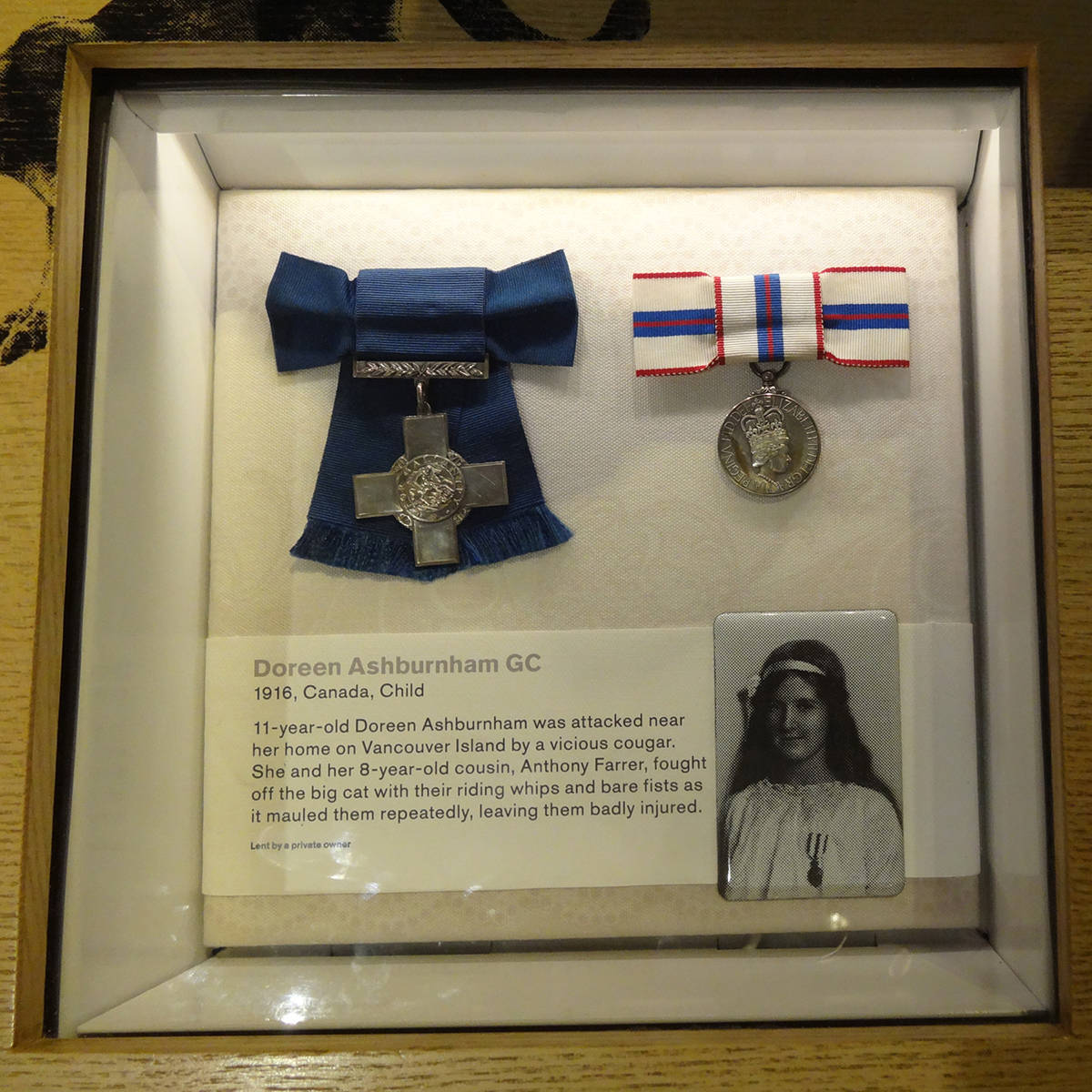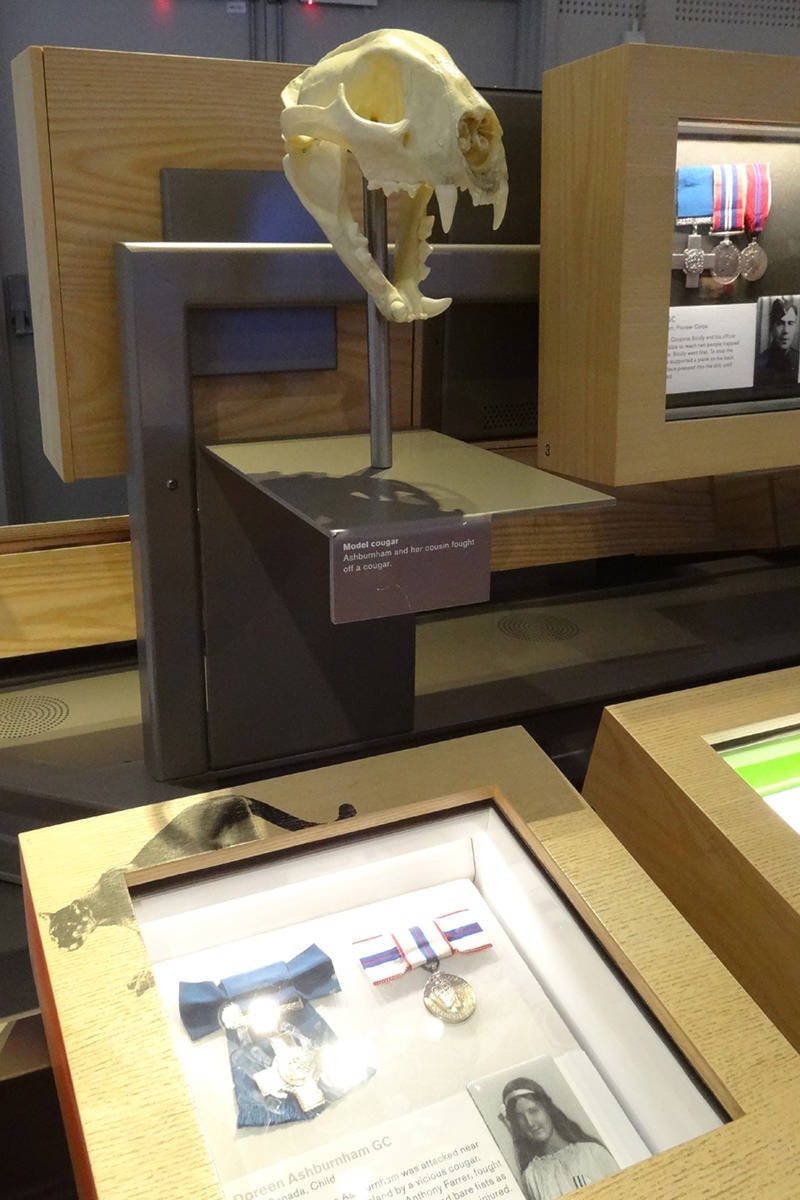“As I walked along the last row in the Gallery, a skull mounted by one of the displays caught my eye!”—Alison Irwin.
Some stories are just too good to be filed away and forgotten. A perfect example is that of Lake Cowichan’s famous cougar attack, when a young girl and an even younger boy fought off a full-grown and starving female cougar with nothing more than their bare hands and their horses’s halters.
Yes, I’ve told this story before. It recently resurfaced in, of all places, my online mailbox, with an email from fellow history buff Alison Irwin; she’d just visited London, England with husband Tony and their son.
But let Alison tell you herself: “When Tony and I were away last month, our last major stop while travelling with our son in London was the Imperial War Museum. Once inside the building, the three of us headed off in different directions to see the exhibits. I made it up to The Lord Ashcroft Gallery on Level 5; that’s where you can read about the people who have been awarded the Victoria Cross and the George Cross.”
Here I’ll interject: The Victoria Cross is the British Commonwealth’s highest award for military gallantry; the George Cross, originally the Albert Medal for Lifesaving, and the George Medal, honour extraordinary bravery by civilians and service personal in non-warlike circumstances.
Back to Alison: “As I walked along the last row in the gallery, a skull mounted by one of the displays caught my eye! It was a cougar’s skull, and below it was the picture of a young girl, Doreen Ashburnham. Having worked at the [Cowichan Valley] Museum in town, I recognized the story and was thrilled to see an item with a connection so close to home.”
Alison also sent along the two photos which accompany today’s Chronicle.
The criteria for a George Cross is strict, being awarded for “acts of the greatest heroism or of the most conspicuous courage in circumstances of extreme danger”.
Think about that for a moment. Then reflect upon the fact that two children in the Cowichan Valley earned its predecessor, the Albert Medal for Lifesaving, a British medal awarded to “recognize the saving of life”. Named in memory of Prince Albert and instituted by a Royal Warrant in 1866, the Albert originally was awarded to recognize saving life at sea. A further Royal Warrant in 1867 created two classes of Albert Medal, the first in gold and the second in bronze, both enameled in blue. The George Cross was instituted in 1940, the Albert discontinued in 1971.
Now to get back to Doreen Ashburnham and Tony Farrar. Her photo, as noted, is on display in the Imperial War Museum — pretty exalted turf, to say the least. But poor Tony has fallen between the cracks. To explain this apparent oversight I must take you back a century. I’ll be brief as I’ve told this story before, as recently as last spring…
On Saturday, Sept. 23, 1916, Doreen and Tony were walking along a forest trail, bridles in hand, to their pastured ponies. Suddenly, a cougar pounced on 11-year-old Doreen from behind, knocking her to the ground. Tony, just eight, flailed at the cat with his bridle, causing it to release her and to rise up on its hind legs to meet their combined assault with their fists.
Tony was first to go down; as the cougar tore at his scalp with its claws, Doreen jumped onto its back, trying to pull its head back and gouging at one of its eyes before thrusting her arm into its mouth.
Astride the enraged animal’s back, her right arm clenched between its teeth, she yelled for Tony to flee. Somehow she managed to free herself after looping her pony’s bridle around its head, effectively muzzling it. As the cat frantically tried to tear itself loose, Doreen joined Tony in flight. The cougar was subsequently tracked, treed and shot. Examination showed it to have been old, visually impaired and undernourished.
Both children had been seriously mauled and would bear their scars for life, Tony having been almost scalped and requiring 72 stitches.
B.C.’s Chief Justice Gordon Hunter, who’d been staying at Cowichan Lake, declared that he would nominate them for the Royal Albert Medal. News reports stated that Doreen and Tony would also be nominated in the U.S. for Carnegie medals after former president Theodore Roosevelt “congratulated British Columbia for having two such heroic youngsters”.
Five months after their terrifying adventure, King George V approved the awarding of the Royal Albert Medal of the Second Class to both youngsters. Their case had been presented in London by the Royal Humane Society and ex-premier Sir Richard McBride.
Doreen went to live in the States, married and had a colourful — some have said fanciful — career. She claimed to have been presented as a debutante to King George V, taught to play polo by Will Rogers, competed internationally as a show jumper, and served as a civilian transport pilot during the Second World War before marrying a university professor.
Upon graduation from Brentwood College where he was a star athlete, Tony Farrar served in the 16th Canadian Scottish Regiment then transferred to the Prince Patricia’s Light infantry. At Manitoba’s Camp Hughes, in July 1930, the 22-year-old Lieut. Anthony J.L. Farrar made newspaper headlines for the second and last time. During a firing practice on the rifle range he was struck in the head by a bullet (allegedly discharged after the order to cease firing) and killed.
Hundreds attended his funeral, conducted with full military honours, in Victoria. Mourned the Colonist: “…He has been cut off in the flower of his youth, but he has left memories to his generation of devotion, courage and sportsmanship that are well worthy of emulation.”
He’d been married for less than a year.
Every year, Doreen attended ceremonies held in London for recipients of the George Cross which had replaced the Albert Medal, originally awarded to her and Tony, and for which she’d exchanged her Albert by invitation in 1974.
Thus it is that Doreen Ashburnham’s name is listed on the Register of the George Cross. In 2000, she was posthumously acknowledged as the GC’s youngest recipient when her medal went on the auction block.
But not Tony Farrar, who was just eight years old — three years younger — when awarded his Albert Medal. This, because his family hadn’t exchanged the Albert for a GC. When Doreen’s daughter placed her famous GC up for sale, a brief news account didn’t even mention Tony by name.
So goes history. For Doreen, eternal international fame. For Tony, every bit as brave, an early grave in Victoria’s Veterans Cemetery.
Thanks again to Alison Irwin for reminding us of this epic Cowichan Valley cougar tale, and the for photos.
P.S.: If you want to see how big a full-grown cougar really is, close-up, there’s a stuffed one in the B.C. Access Building on Duncan Street.

